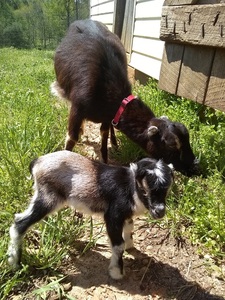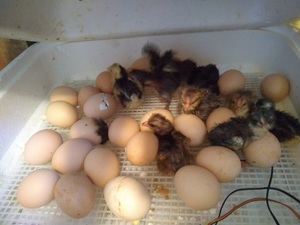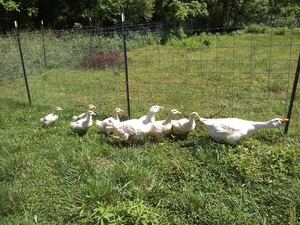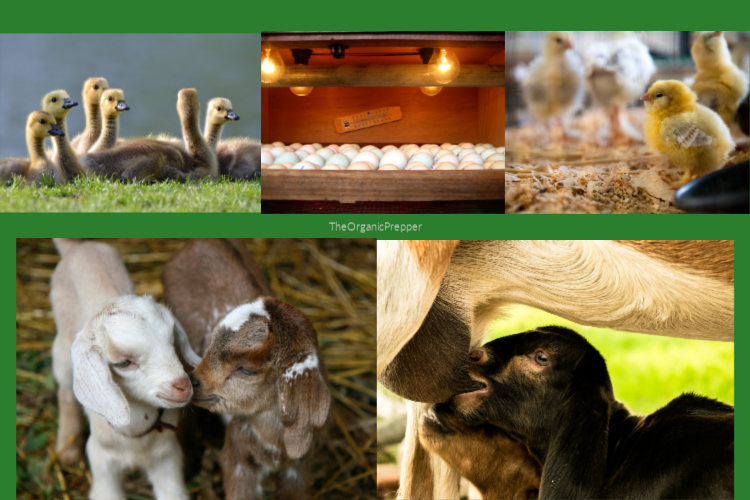If you're new here, you may want to subscribe to my RSS feed. Thanks for visiting!
by Kara Stiff
Spring and summer on a homestead are the seasons of new babies. It’s a time of excitement and unbearable cuteness and unexpected problems, extra work, and potential emergencies. Getting ready to welcome this year’s crop of little goats, geese, and chickens means I need to have the right supplies on hand, but it’s even more critical that I get in the right frame of mind. If I’m short on supplies, the local Tractor Supply is still open (for the moment, with reduced hours, so we’d better not schedule any emergencies after 6 p.m.). But if I’m short on information and attention, things will go seriously wrong.
Aiming for a smooth delivery
Last year I only had two doe goats due, so kidding was over in a week. This year I have four, two already done, and two left to go. One of these was too young to breed during the regular time. Another was ill last fall, so I let her regain condition before the stress of pregnancy. We’re relatively new at kidding, so it’s still a nervous process full of questions. Is she actually pregnant? How many are in there? Will they get out okay or get their legs all wrapped around each other in a goatherd’s delivery nightmare??
The truth is, I haven’t yet had a problem delivery. Most of my moms have been first fresheners (it’s their first baby), and all have delivered on their own with no issues. Of the five kids born here so far, I’ve entirely missed the births of four, and it’s not because I’m not checking on them. As kidding approaches, I spend a lot more time at the barn observing, checking does for signs of labor or impending labor, and just generally attuning my senses to what’s happening out there.
Be prepared! Even careful observation doesn’t always work.
Last year a first-time doe was placidly chewing cud, no signs of labor, and when I got back to the barn 40 minutes later, she had a baby already up and nursing. This year the first doe kidded three weeks before I was expecting her to. Surprise!
Part of our success so far is just luck. We will eventually have a problem delivery, so I’m ready at the start of the season with warm, clean towels, a flashlight, a way to sanitize my hands, and a reasonably good idea of what I may need to do to get a stuck baby out. The phone number of an experienced local goat handler is also an essential preparedness item. Having a goat mentor is priceless.
What else can be done to help ensure healthy farm babies?
Another part of our success is supplementing our animals carefully with selenium and zinc, both of which promote a functional reproductive system. Selenium, in particular, is critical. Without enough, the doe’s muscles will tire too quickly. Even if she can get baby out, she may fail to expel the placenta, which is fatal. A baby born selenium-deficient will have white muscle disease. My goats get 4ml of selenium and vitamin E paste once per month. My does in the last several months of pregnancy get 6ml. Some soils have too much selenium rather than too little, so this issue is place-dependent (more on selenium in our herd here).
Vaccinating mom with a goat or multi-species CDT (tetanus shot) is also part of our protocol. Some data suggest the ideal time is between 60 and 30 days before kidding, to let mom develop antibodies before birth but also to let baby develop them, so they are already protected when they are de-horned at 7-10 days old. Baby gets another shot at de-horning, and another one 21 days later. I have used this protocol with success and never had a tetanus problem, but I am pretty concerned about tetanus after hearing what an ugly death it is. I was distraught when my favorite little doe spiked a fever (and a great big swollen lump) immediately after de-horning this year. My goat mentor correctly diagnosed it as a general infection, and I was able to treat it with penicillin I had on hand.
Managing kids

Babies have to get dry and warm pretty quickly if the air temperature is cold. Mom has an instinct to lick the goo off the kid, but one of my new moms didn’t get the concept until after I had already dried the shivering baby with a towel. Then, mom licked the dry baby, the towel, and my hands and coat and face.
We have no electricity in the barn, so I have found myself holding a newborn kid in my coat for an hour or two to get her body temperature up.
A first freshener may not stand to let baby nurse, instead walking away or kicking the baby off. It’s a new sensation, and udders are ticklish! To get a new mom used to the feeling of fingers or baby goat noses down there, I feed her on the stand and let her practice having her udder touched at least once every couple of days in the weeks before kidding. Doing this also makes her easier to milk from the beginning.
Another potential problem is that mom may let baby nurse, but the baby may nurse only one side. Sometimes with multiples, all of them will nurse the same side of mom. None of them will get enough milk, while the other side of mom is full to the point of damaging the udder. They have to be directed to the other teat.
A little help for mom and babies
I know many people let mom manage the baby entirely by herself for two weeks before they begin separating the kid at night to get a little milk for the kitchen. My preference is to put each of my does on the stand once a day from two or three days after birth, milk out whatever the kids haven’t taken (it’s often quite a bit for a first freshener with a single little kid), and make sure the udder is staying healthy.
I have bottle-raised kids from two weeks, and while it’s adorable, it’s a lot of work. First, it takes a couple of days, offering them a bottle at close intervals for them to catch on. By “offering,” I mean stuffing the nipple in their little-bitty mouths and holding it there while they scream, but not letting them choke. It’s hard to get anything else done during those days, and I always somehow get milk in my eyes. Plus, if you’re bottle-feeding, then mom must be milked twice a day without fail, and bottles have to be managed and cleaned. Remembering to get to the barn on time for the mid-day bottle is especially hard for me in the midst of a busy spring season.
This year my does are raising their babies. These babies are turning out almost as friendly as my bottle kids. It’s crucial for them to sit on somebody’s lap for a while soon after birth, and to keep having contact with people several times a day, every day. I was hoping this group of babies might be a little less friendly than previous because I wouldn’t mind owning a goat that does not run over and jump up on me as soon as I enter the paddock. But it looks like I’m out of luck. They’re all little jumpers.
Many people wean kids at eight weeks, but my local goat friends and I have found this to be too early. It’s a stressful time for the animal no matter when it happens, but if it happens just a little later, we’ve seen less severe coccidia (a diarrheal disease especially hard on kids). I think it’s good to allow the kid a little extra nutrition as their rumen develops, and it certainly does them no harm. One of my goat friends recently noticed her doe was still nursing a yearling. “It’s like if I was nursing my college student!” she said.
RELATED: How to Use the Whole Animal (Whether You Raise Your Own or Buy from the Store)
When bottle-feeding, I’ve had a lot of success dropping to one bottle a day at eight weeks, and only stopping completely at 10 or 12 depending on the health of the individual animal. That’s also when I start supplementing with copper, although I start selenium earlier. Regardless of exactly when babies are weaned, the beginning of kidding means the goats will need a lot more of my attention for the next three months, and I need to take that into account when planning my other activities.
Poultry have different needs
I find managing baby birds to be very different than mammals. Our domestic poultry are ground-nesting birds, which means their babies are up and ready to go pretty quickly. In contrast, to say, a parrot, which is born just as helpless and wrinkly as a human, and is even more trouble to hand-feed than a goat kid. Chickens can get themselves to the food and water; my job is just to assure that food and water are available, the temperature is within the correct range, and no snakes or other predators can get at them.
When we raised our first batch of chickens here at the homestead, I was hoping they would get onto raising their own babies and save me the work, but that hasn’t happened yet. I do have some hens of breeds that have not had the broodiness bred entirely out of them, but no individual chicken has set a nest. This spring, I incubated 42 eggs. This is my third round of chickens at the homestead, but my first go with an incubator, and I immediately ran into a particularly North Carolinian problem.
What could go wrong with incubators?
The internet and my chicken mentor agree that the incubator’s humidity definitely shouldn’t be above about 60% (although there is some debate over what the very best range is). This is because eggs are porous, and the moisture in them must evaporate at a special rate so that there is a big enough air space and a fragile enough membrane that the chick can get itself out of the egg on the right day. The incubator has to match the conditions under the fluffy butt of a chicken pretty precisely, or the process fails.
At the bottom of the incubator are several cells for water, so I can fill the right area to achieve a reasonable range. But it has rained and rained here, and for the first week of incubation, the air was so humid that the right number of wet cells was: none. It took me a couple of days to figure that out. I emptied the cells and carefully watched the humidity, adding water back when it fell to 50%. This was easy because I put the incubator right next to the toilet, where I would be sure to peek in curiously about twelve times a day.
Due to a thunderstorm, the power went out for several hours. We have a backup solar generator, but it got a little wet and suffered a short. I mentioned the eggs would die in a couple of hours. I took the incubator up to a friend who still had power. Not very prepared of us. When the eggs came home the next day, I candled them: putting a light up to the shell to see if there were chicks in there. My mentor suggested I use the flashlight on my phone, sure enough, it works like a charm. Every single egg was developing. In the process of candling, I clumsily dropped an egg and cracked it. I melted a little paraffin over the crack to keep bacteria out and hoped for the best.
RELATED: How the Economic Crisis Affects Homestead Decision-Making
Humidity came back up to too high a level. Unwilling to crack any more eggs, I just left it. On day 18, I removed the egg turner (a device that gently rotates the eggs while they develop) and left the humidity high (above 70%). I candled again, more carefully this time, and discovered that all but four had kept developing after the power outage, including the cracked one. On day 21 at 4 a.m., I heard some peeps. Four of them had hatched. (The cracked one also did not complete its development.)
After hatching: what’s next?

I’ve found it isn’t safe to let them in with the mature flock until they are almost fully grown. Full-grown, chickens need to be allowed to get used to each other through a fence for a week or kill each other. I’m still hoping to get some useful chicken mothers, but even raising them myself is worth it because they provide so many services on the farm.
Learning about geese
I’m a newbie at geese. I acquired a pair of mature Embdens last summer after a raccoon developed a habit of eating one hen per day in broad daylight in the middle of my fenced pasture. Since I got the geese, I haven’t lost another hen to any daytime predator, so I consider them to be earning their keep. It was just gravy when my goose started laying eggs.
Then she kept laying and kept laying until she had a pile numbering over 20. I became pretty nervous, worrying that she was never going to start sitting on them. Then I learned that Embdens can set up to 40 eggs! Serves me right for not doing my research.

The gosling made it out but suffered from an abdominal hernia, which is a common result of getting too cold in the last days before hatching (as mom left the nest). I tried to introduce it to the flock, and it seemed to do okay for a few days, but then its condition deteriorated rapidly, and I had to cull it.
This always grieves me, because I want everything to have a chance to live and thrive, but I know that birds are fragile. The other seven goslings are doing well, doubling in size every few days and quickly approaching the ugly stage. I hope to keep a few and eat a few in the fall.
Which babies do you raise? Share your stories and tips!
Every spring, my family and I learn something new about raising babies. I’ve certainly made many mistakes and will probably continue to do so, but we’ve also had lots of good successes.
About Kara
Kara Stiff grew up in Anchorage, Alaska and got her BS in Sustainable Agriculture from the University of Maine. Now she lives with her husband, two small children, and some number of goats on 17 acres in rural North Carolina. She documents her family’s journey toward resilience, community engagement, and a lower environmental impact at low-carbonlife.org.

















9 Responses
I’m working on a batch of chicks right now. In raising hogs you gotta make a space them babies can get to where mama don’t lay on them. We just run 2x4s along the side of the hutch bout 8″ off the ground.
Birthing is an experience I’ve done with several critters. You ain’t lived till you been up to your shoulders lol.
It’s not easy and there will be some heartbreak but in the long run it’s worth the time and effort.
I’m expecting 12 chicks in August. Already I am running around gathering everything I will need for them. I feel like an expectant mother!
Many bantam breeds make excellent brood hens, and will look after the chicks until they are fully feathered out (around 6 weeks). Just make sure they get to sit on those eggs (or fake eggs) for at least 21 days – otherwise they may not be emotionally ready to be a mother and can actually be aggressive towards the chicks.
I’ve raised quite a few chickens, and also a couple of ducks, and I can tell you that the only good mom hen I ever knew was a bantam breed. I’ve found (and this has been backed up in older homesteading books) that bantam breeds have much more mothering instinct left in them than your modern meat and egg breeds. Of course, quite a few generations of chickens have been born in the last thirty years, so things might have changed a bit. However, if you want good mothers, the “wilder” the breed of chicken, the better.
We have 3 free ranging hens that belonged/ were raised at the next door neighbor’s and decided to move over to our place last year. Neighbor also acquired several free ranging roosters this winter that were basically almost killing the hens, until local predators eliminated all but one.
Anyhow, all 3 hens contributed eggs to a clutch this spring & the Buff Orpington hen chose to brood and raise the chicks.
Chicks are 8 weeks old now, Mom said they were all on their own a few days ago. Chicks are free ranging during the day, come back to their pen & coop at supper time each night.
Guardian, the big rooster has been slowly integrating the chicks into his flock during the day. It’s been very interesting to watch Guardian interact with the chicks & distract any aggressive tendencies the adult hens display..
We also have goats. I highly recommend Deborah Niemann, The Thrifty Homesteader as a resource. She has a great online newsletter & videos on all things Goat! Excellent information on how to tell when the doe is close to kidding, videos on the actual birthing, including problem births, videos on dehorning and castration.
As for chickens, I had really good luck with French Freedom Rangers. Good layers and meat birds.
Currently I get a mix from a neighbor.
Ducks, runners are good so are Cayugas, but both had a tendency to want to go across the street to the neighbors.
Currently have Pekins and they seem to be fairly easy to train to stay in one area.
Had to help out with goats kidding out more than a few times. Had a few reject the kids too, so hand feeding it was.
Forty years ago we kept a herd of 15 goats. One morning, snow on the ground, before heading off to work (in suit and tie) I poked my head in the barn to check if everything was OK. And discovered a doe giving birth. She’d already had one kid (who lay on the floor shivering) and she was struggling to deliver number two. I yelled for my wife who came running with a blanket. She then went back to the house and got a dish and an eyedropper. The initial “milk” from mama goat is really colostrum (and not true milk). We held mama goat down and pressed some milk into the bowl. We spilled some but did manage to get a bit in the eyedropper and squeeze it into baby goat’s mouth. By that time baby goat’s shivering had stopped and its eyes were starting to glaze over. I thought for sure it was a goner. Our efforts were too little, too late. Then its eyes popped open! AND IT JUMPED TO ITS FEET. It was probably the most miraculous thing I’ve ever seen. You had to be there. I start to tear up just remembering it. Baby goat grew up well and strong.
Please don’t take what I am about to say the wrong way, because I completely respect the attention and effort required to successfully raise chickens, goats, geese, et al.
After reading these anecdotes, I have to wonder how these species ever survived without human intervention.
The truth is, while some individuals didn’t make it, the species did go on to survive and thrive.
Domesticated animals have been bred over centuries, even millennia, to produce more of what we humans want: milk, fiber, eggs, etc. and any trait that interferes with this is deemed to be undesirable. Chickens have had the ‘broodiness’ bred out of them, because that results in lower egg production. Domesticated sheep generally produce considerably more fiber than wild sheep and so need humans to shear them. Many dairy animals have been bred to give birth to larger offspring (complicating delivery) and to produce prodigious amounts of milk, far more than their wild counterparts. For this reason, we humans have a responsibility to these animals, because we created in them traits that would make it difficult or impossible for them to live without human intervention.